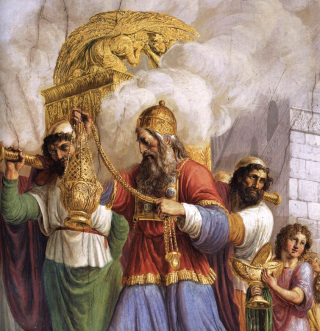For many years after the time of Moses, the office of high priest was held based on heredity. It was considered a lifelong position. The Great Sanhedrin alone had the right to appoint or confirm a priest.
In later times, however, civil authorities appropriated the right of appointment and filled the position based on their own religious and political considerations. For example, Herod the Great appointed at least six of them, a frequent turnover that the New Testament hints at (John 11:51).
Qualifications
There were other qualifications for becoming High Priest other than heredity. Although the age of eligibility is not fixed in the Bible, according to rabbinical tradition it was twenty years old (2Chronicles 31:17).
The man considered for this office had to be married, and his wife had to be an Israelite maiden (Leviticus 21:13 - 14). He was expected to be superior to all others in physique, in wisdom, in dignity, and in material wealth. In fact, if the High Priest was poor it was considered the duty of others who served in the temple to contribute enough money to make him rich!

Those who entered this critical office was considered the presiding officer of the Sanhedrin (supreme council of the Jews who met in Jerusalem). He was also the only one allowed to enter the Holy of Holies inside Jerusalem's temple, and that once a year, on the Day of Atonement (Yom Kippur - Leviticus 16). He was not permitted to come in contact with the bodies of the dead, not even of his own parents. He was not permitted, as a sign of mourning, to leave his hair disheveled, to expose it, or to rend his garments (see Leviticus 21, etc.).
Priests
These men, in general, were responsible for the temple and its sacrifices, and thus were some of the religious and social leaders of the Jewish people. They also took care of the ritual concerns. Others of the tribe of Levi also took part in the operation and maintenance of the temple. Those who did or would soon serve in God's house of prayer lived near it.
". . . on the Levites devolved the Temple-police, the guard of the gates, and the duty of keeping everything about the sanctuary clean . . . at night the priests kept watch . . . half of each of the twenty-four 'courses' . . . were permanently resident in Jerusalem" (Temple at the Time of Jesus, Chapter 4)
The Gospels inform us that temple priests were instrumental in not only having Jesus arrested but also killed. Jesus knew in advance that he would suffer and be put to death by them (Matthew 16:21, Mark 8:31, Luke 9:22). They were among other leaders who challenged Jesus' authority just days before the crucifixion (Matthew 21:23, Luke 20:1 - 2).
Priests and other religious leaders met just a few days before the Passover to plot the murder of Jesus (Matthew 26:3 - 5). It would be these same men who would soon hear Jesus' testimony after his arrest and condemned him to die (Matthew 26:57, 59, 66).
It was elders and other religious leaders who bribed Judas with 30 pieces of silver to betray Jesus (Matthew 26:14 - 16). After his arrest, Jesus was taken to an assembly where many of them were gathered in order to judge him. The conclusion of the mock trial was that Jesus was (falsely) accused of blasphemy and therefore deserved the death penalty (Mark 14:61 - 64, Matthew 26:62 - 66). Amazingly, even though most priests were against Jesus, a great number of them eventually were converted and became Christians (Acts 6:7).